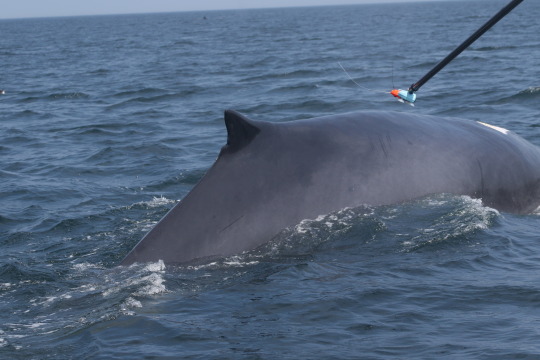#WhaleTagging
Text





Suction cups- used for conducting research on whales and for holding your squeegee up in the shower!
Recently, we shared a clip of researchers and scientists in NOAA’s Stellwagen Bank National Marine Sanctuary placing a synchronous motion, acoustic, and video recording tag (CATS tag) on the back of a fin whale. The tag, which is held in place by suction cups, allows the team to investigate the whale’s foraging behavior and the noise field received by the whale. Visit our Instagram or Twitter to view the original video.
But, how does this suctioned tag stay attached to the whale?
Once the tag is attached and the whale goes on a deeper dive, the increased pressure helps to push the suction cups on more, getting an even better attachment. These suction cups may be a little stronger than the ones you use in your shower, as this new suction cup technology allows for attachments ranging from few hours to a few days.
NOAA researchers use suction cupped CATS tags as a non-invasive research method so it does not hurt the whale, and if it really wants to, the whale can get it off anytime it wants by breaching (jumping out of the water) or rubbing the bottom. NOAA’s Stellwagen Bank National Marine Sanctuary only uses suction cup tags (CATS or DTAGS, another similar sound and motion tag) for the whale research conducted in the field.
Research is conducted under permit No. 18059 issued by the National Marine Fisheries Service to Dr. David Wiley, the sanctuary’s Research Ecologist. The team includes scientists from Syracuse University, University of Michigan, University of California Santa Cruz, Center for Coastal Studies and Ocean Alliance.
#EarthIsBlue#WhaleTagging#Whale#MarineScience#MarineBiology#NOAA#nature#science#national marine sanctuary#noaa#earthisblue#conservation#ocean
143 notes
·
View notes
Text
Check this out! 🐋
Dr. Tammy Silva (piloting) and Michael Thompson (pole tagging), of NOAA’s Stellwagen Bank National Marine Sanctuary, place a synchronous motion, acoustic and video recording tag (CATS tag) on the back of a fin whale. The tag, which is held in place by suction cups, will allow the team to investigate the whale’s foraging behavior and the noise field received by the whale. It is one of only a few fin whales to be tagged with such sophisticated instrumentation.
The team includes scientists from Syracuse University, University of Michigan, University of California Santa Cruz, Center for Coastal Studies and Ocean Alliance.
Research is conducted under permit No. 18059 issued by the National Marine Fisheries Service to Dr. David Wiley, the sanctuary’s Research Ecologist. Video credit: D. Wiley
#EarthIsBlue#WhaleTagging#Whale#Whales#NOAA#StellwagenBank#MA#Nature#Ocean#Sea#Wildlife#Underwater#MarineLife#Conservation#Science#Research#MarineScience#MarineConservation#Stellwagen#Massachusetts#WildSanctuaries#FinWhale
34 notes
·
View notes